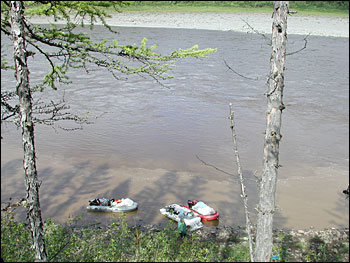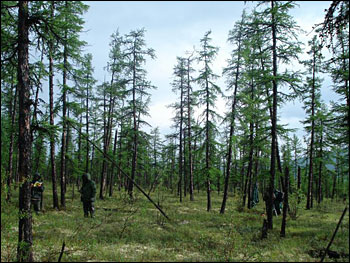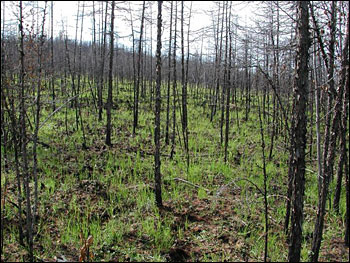| |
Saturday, August 11, 2007
From Evenkiyskiy Region, 11:56 p.m. Siberia (11:56 a.m. EDT)
From Jon Ranson
It has been a long day on the river! We got up early, had a quick breakfast, broke camp and were on the move by 9:30 this morning.
I’ve said our destination was Tura, but that isn’t exactly precise. We are in a cabin just north of town at a field camp run by the Sukachev Forest Institute. It’s still basically wilderness, but instead of rocks and tents we have beds and a cabin. We also have running water and electricity here, so I should be able to get online, finally!
On the river today we saw boats coming towards us for the first time. I guess everyone was feeling good, because they started some teasing. “Look, they are delivering Paul’s pizza!” someone shouted. Then to my surprise, someone said “Oh, maybe they are delivering Jon’s bag!” Now, I know Paul has talked about pizza non-stop for days, but I thought I’d been quite stoic about that lost bag of mine. Well, maybe not!
|
|
- Introduction
- July 28, 2007
- July 29, 2007
- July 30, 2007
- July 31, 2007
- August 1, 2007
- August 2, 2007
- August 3, 2007
- August 4, 2007
- August 5, 2007
- August 6, 2007
- August 7, 2007
- August 8, 2007
- August 9, 2007
- August 10, 2007
- August 11, 2007
- August 12, 2007
- Biographies
|
| |

Today’s amazing find was a huge area of burned forest. It was tens of kilometers wide and long. It was fairly freshly burned—sometime in the spring we think. In the lab I’ll look at data from our remote-sensing systems—especially MODIS and GLAS—and be able to tell the date and extent of the fire.
When we entered the area, we could smell smoky, charred ashes. The ground was covered by dried, fallen needles from the dead larch. The fire had been a low, hot ground fire that burned all moss, brush, and grass from the ground and scorched the tree trunks. It killed the larch trees by heating the soil and scalding the shallow roots, but it left the crowns of the trees untouched. With all the trees dead, the needles slowly dried and fell down like Christmas trees left too long in a house after the holiday.
|
|
Just downstream from the tributary, the Kochechum River has muddy waters, obvious near the shore.
|
| |
 |
|
Along the Kochechum River in northern Siberia, larch is the most common tree. Well adapted to fire, trees often bear fire scars that let scientists study the fire frequency in the area. Swathed in mosquito netting, the team takes measurements in a larch forest where the trees are all of a similar age and size. This similarity suggests they all sprouted at the same time following a major disturbance event, probably a fire.
|
| |

We also saw many signs of forest regeneration. The larch seeds have not yet sprouted—the seedlings will appear in the spring. There were patches of green grasses here and there on the dark mineral soil. Small alders and willows were burned by the fire, leaving charred bushes 2-3 meters high. Because they have deep roots, the roots are still alive and they put forth lots of new green shoots at the base of these skeletons.
There has been a heavy rainy season. So in some areas the dead trees stood in muddy water, not soil. There were many areas of erosion, where water rolled from the forest into the river in rivulets. In one place the run-off looked exactly like chocolate milk pouring into the Kochechum. This river has been full of silt and mud anyway, which speaks to its strong powers of erosion. But below the burns the water was extremely muddy.
It struck me just how much impact forest fires here have on erosion. Of course, this forest sediment then gets carried from this little river to other rivers far, far downstream. Could this sediment make it into the Arctic Ocean? Or will it be deposited elsewhere? If so, how will it change the shape of the land? We have come on this expedition to find answers to our questions, and we have made great progress. It is clear, however, that there are many, many more questions begging to be studied.
 August 12, 2007 August 12, 2007
 August 10, 2007 August 10, 2007
|
|
Skeleton trunks of larch trees remain standing after a fire that burned through the area earlier in 2007. The forest still smelled like charcoal when the team passed through. The burn was a very hot ground fire, which killed the shallow roots of the standing larch trees without burning the trunks or even the needles. All of the ground cover had been burned, and the mineral rich soil was exposed. The dried larch needles had fallen to the ground, and grasses had begun to sprout. In the cold Siberian climate, these trees will decompose extremely slowly, if at all. They will stand in this charred condition for decades.
|

